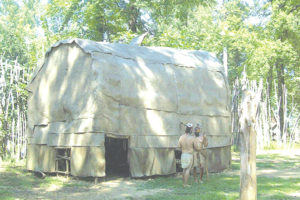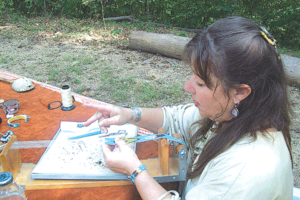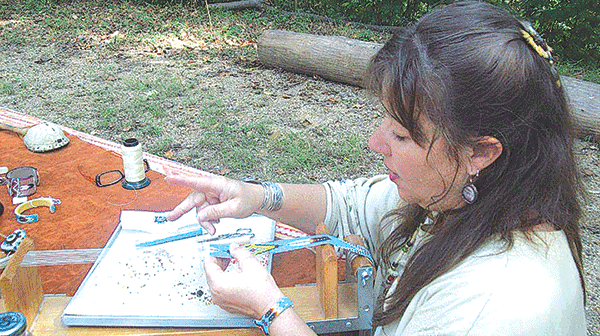

ABOVE: Left, A Native American yehakin, or longhouse, is pictured at Henricus Historical Park. On right, Tamsye ‘Little Dove’ Stover of the Chickahominy Tribe has appeared at past Henricus events and demonstrated beadwork and crafting.
Since 1996, Virginia has recognized November as American Indian Month.
In Virginia, there are seven federally recognized tribes: Chickahominy, Chickahominy Eastern, Monacan, Nansemond, Rappahannock, Upper Mattaponi and Pamunkey.
Virginia is home to four state-recognized Indian tribes: the Cheroenhaka (Nottoway), Mattaponi, Nottoway of Virginia and Patawomeck.
“Thousands of American Indians from outside of the Commonwealth have moved to Virginia and made it their home,” Gov. Ralph Northam said.
Chesterfield County is rich in Native American history and has many resources for exploring and learning indigenous history and culture.
The county museum, 6831 Mimms Loop, has a Native American display with artifacts and volunteers are available to answer questions.
Henricus Historical Park, 251 Henricus Park Road off of Coxendale Road, offers a reconstructed Native American village where visitors can enter a “longhouse” or “yehakin,” and observe and take part in on-site demonstrations by local Native Americans and historical interpreters who portray early indigenous people.
Henricus interprets the culture of the Arrohateck people of the Powhatan Indian chiefdom at the time of contact with the English colonists who arrived in September 1611 under the leadership of Sir Thomas Dale.
One of history’s well known Native Americans, Pocahontas, of the Pamunkey Tribe, also had a presence at early Henricus.
When Pocahontas was kidnapped by the English, she was taken to Jamestown and then to Henricus, where she was placed with the Rev. Whitaker at Rock Hall. Chief Powhatan’s daughter was taught the English language, customs and Christianity. It was during this time that Pocahontas met John Rolfe. She was baptized and given the name of Rebecca. She would later be called “Lady Rebecca” by the English. Pocahontas and John Rolfe married in 1614.
Present-day Native Americans live in many areas of the commonwealth and on tribal land. Native Americans today are politicians, teachers, doctors, lawyers, plumbers, construction workers, actors, singers, firefighters and police officers, whatever can be imagined.
In Virginia and across the nation, Native American gatherings called pow-wows are held yearly and the public is invited. Pow-wows are a time for teaching cultural history through dance and song and meeting the public. Items can be found for purchase, such as pottery, crafts, artwork, clothing and traditional Native American foods.
Note: American Indian Day began in Virginia in 1987; recognition was expanded to a week in 1988; and the General Assembly expanded recognition to a month in 1996. A day of appreciation is held the Wednesday before Thanksgiving Day.


1 Comment
Where in the United States and Virginia Constitutions is the enumerated powers for politicians to make distinguishable a select group of U.S./Virginia citizens distinguishable from all other U.S./Virginia citizens because of the ‘others’ Indian ancestry/race?” Given the 14th Amendment’s ‘equal protection’ provisions foreclosed politicians-state and federal-from making a select group of U.S./Virginian citizens distinguishable from other U.S./Virginia citizens because of their ‘ex-slave ancestry/race,’ how it is possible to make a select group of U.S./Virginia citizens with “Indian ancestry/race” distinguishable?